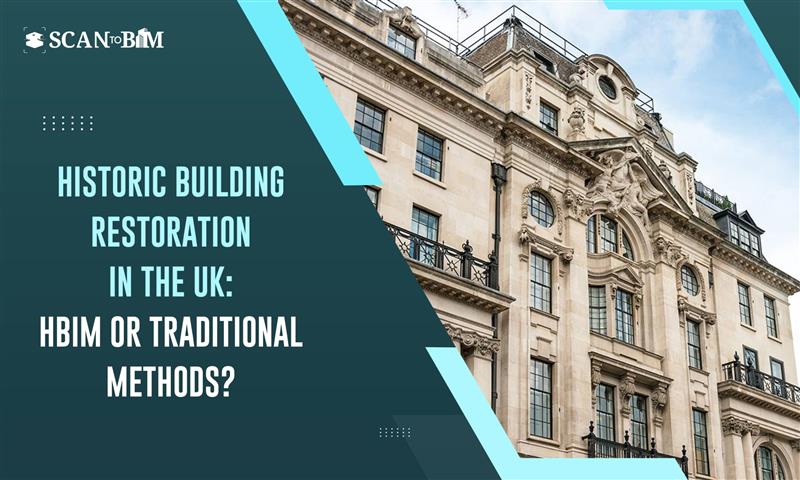
Restoration of historic buildings is a combination of art and science. Over time the technological advancements have revolutionized how the restoration projects are approached. Today, architects and engineers can choose between the Historic Building Information Modeling (HBIM) and traditional restoration techniques. While both have their merits, understanding their differences, applications and relevance is essential for choosing the most suitable approach especially for the UK.
What is Traditional Restoration?
Traditional restoration involves preserving, repairing or reconstructing heritage structures using the conventional methods and craftsmanship. This process heavily relies on:
- Manual surveys and measurements.
- Historic documentation, sketches and drawings.
- Skilled artisans replicating the original materials and techniques.
- On-site inspections and trial-and-error methods.
Traditional restoration aims to retain the authenticity and architectural heritage of the structures like castles, churches and listed buildings. It often focuses on the aesthetics along with the material accuracy.
What is HBIM?
Historic Building Information Modeling (HBIM) is a modern method that integrates the Scan to BIM Services and Point Cloud to BIM Services with architectural, structural and heritage data. It transforms the physical structures into the intelligent digital models through:
- Laser scanning or photogrammetry to create accurate 3D point clouds.
- Integration of material properties, construction techniques and historical data.
- Simulation, clash detection and structural analysis.
- Long-term maintenance and management tools.
HBIM provides a data-rich environment that supports the restoration, renovation and heritage conservation with improved accuracy and collaboration.
Key Differences Between HBIM and Traditional Restoration
| Aspect | Traditional Restoration | HBIM |
| Data Collection | Manual surveys, drawings and records | 3D laser scanning, point clouds, digital models |
| Accuracy | Subject to human error | Highly accurate with measurable precision |
| Documentation | Physical notes and plans | Integrated models with metadata and BIM objects |
| Analysis | Limited structural assessment | Advanced simulations, clash detection |
| Cost & Time | Often longer, requires on-site expertise | Efficient, data-driven, cost-effective planning |
| Maintenance | Paper-based or periodic surveys | Continuous updates and monitoring through BIM |
| Collaboration | Localized teamwork | Cloud-based multi-disciplinary collaboration |
Real Applications in the UK
The UK, with its vast heritage of listed buildings and ancient monuments has seen both traditional as well as the modern restoration techniques being applied across the projects:
Traditional Projects
- Westminster Abbey: Here the restoration was carried out by the master craftsmen using the original stone and timber methods.
- York Minster: Here the repairs were made preserving the medieval architecture focusing more on the skilled masonry and local materials.
HBIM-Driven Projects
- St Paul’s Cathedral: Laser scanning and digital modeling helped in mapping the structural weaknesses and planning repairs. (Source: National Geographic)
- Durham Cathedral: HBIM enabled the creation of a highly detailed model for conservation planning and preventive maintenances.
- Tower of London: Point Cloud to BIM Services were used to capture the structure’s geometry thereby ensuring that the preservation strategies were both precise and minimally invasive. (Source: RIBA)
These examples show how modern tools complements the traditional expertise rather than just replacing it entirely.
Traditional vs Modern Restoration Techniques
Traditional Techniques
- Authentic craftsmanship
- Uses historic materials
- Aesthetic preservation
- Manual oversight
- High labor intensity
Modern (HBIM) Techniques
- Accurate 3D models from laser scans
- Efficient clash detection and planning
- Long-term monitoring capabilities
- Integration with structural and material analysis
- Cost effective and efficient
Which One Should You Choose?
Choosing between the traditional restoration and HBIM depends on the nature of the project:
Opt for Traditional Restoration if:
- The building is of significant historic or cultural value where authenticity is of utmost importance.
- The skilled artisans are available and materials can be replicated accurately.
- The focus is more towards the aesthetic preservation rather than just the structural modernization.
Opt for HBIM if:
- The project involves the complex geometry or requires the detailed structural analysis.
- Long-term monitoring, maintenance or sustainability plans are needed.
- Collaboration between the multiple stakeholders is required across different locations.
- You want to integrate the modern technology without disturbing the historical character.
Hybrid Approach:
Most modern restoration projects in the UK are a blend of both. The HBIM provides the technical backbone thereby ensuring the accuracy and long-term management while the traditional craftsmanship delivers the authenticity as well as the cultural integrity that defines the heritage buildings.
Conclusion
The debate between the HBIM and traditional restoration is not just about choosing one over the other but understanding how to balance the heritage along with the technology. The use of Scan to BIM Services and Point Cloud to BIM Services in the projects has revolutionized the restoration planning hence offering the architects and conservationists the unmatched precision and efficiency. At the same time, the traditional methods preserves the essence of the architectural history while keeping alive the artistry of the generations past.
For restoration in the UK and beyond, embracing a hybrid strategy that combines HBIM with traditional techniques offers the best of both worlds while ensuring that the heritage structures stand strong today and even for the generations to come.